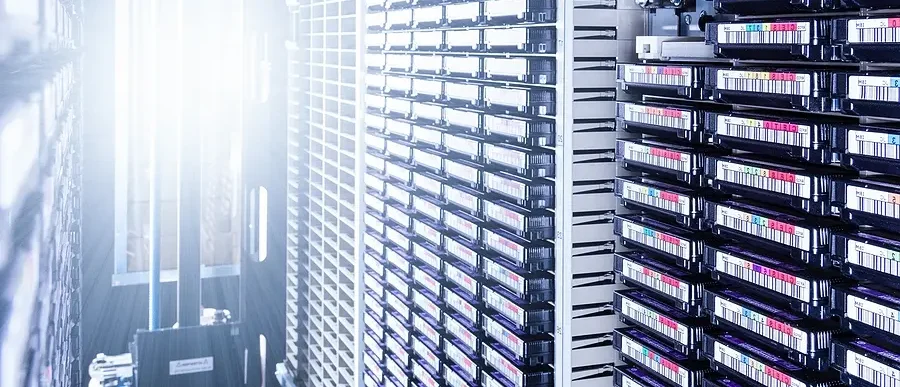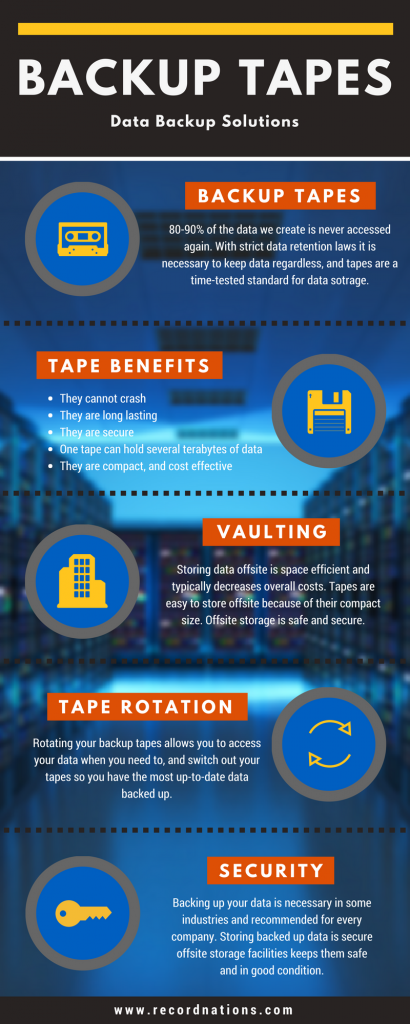
In a fast-paced world filled with data-driven decisions, losing your data can have severe repercussions on your business. Data loss can cause financial issues and lead to a poor reputation as a business. With the prevalence of data breaches, cyber-attacks, and basic human error, finding efficient ways to store your data matters when it comes to safeguarding your business data.
Among the many digital options, some businesses use a unique form of data backup that effectively stores digital copies of documents. Tape backups are a format that, despite its antique appearance, has many benefits. We’re here to explain why some businesses use tape backups as an effective way to store their data and help you decide whether to use them for yourself or move towards more digital, cloud-based solutions for your business.
What is Tape Backup?
Tape backups used to be the main method of securing and backing up data in the 1960s and 70s. It’s a backup procedure that uses tape cartridges as storage devices. Large amounts of data found on hard disks can be duplicated to these tapes to protect against a hard disk crash, and the data can be restored using a tape backup.
While most people have switched to online cloud storage in these cases, tape backups continue to exist because they provide archival stability. These backups work on large and small-scale backups and can be considered an inexpensive option for larger data capacities.
How Backing Up Tapes Compare To Other Methods
 While tape backups provide a sufficient way to transfer and store data, there are other options to consider when looking for methods that meet the criteria of price, labor, longevity, and efficiency. If you’re trying to plan for the future and replace old, outdated infrastructure such as physical, paper copies, and paper cabinets, then here’s a brief comparison to consider when making your choices.
While tape backups provide a sufficient way to transfer and store data, there are other options to consider when looking for methods that meet the criteria of price, labor, longevity, and efficiency. If you’re trying to plan for the future and replace old, outdated infrastructure such as physical, paper copies, and paper cabinets, then here’s a brief comparison to consider when making your choices.
Disk Backup
Disk-based backups are quicker and more reliable for storage than tape-based backups, as they avoid the hassle of retrieving, sequencing, and replicating tapes individually. This method works for disk-to-disk transfers, but the biggest drawback is that it requires either an efficient onsite provider location or would need to be circumvented to a third-party storage facility, which can be costly.
Cloud Backup
Cloud-based storage uses a third-party service to store data per gigabyte. There’s better cost efficiency with this method, and it’s less labor intensive, as the data is handled and replicated as a managed service, eliminating the hours spent physically managing backups or securing tapes. However, this method requires an appropriate amount of bandwidth to support, meaning you may need to spend money on better network optimizations to support it. It’s a flexible backup option, and most third-party providers offer secure systems to protect against data breaches and cybersecurity attacks.
Tape Backup
As previously stated, backup tapes use magnetic disks and other tape types to store data. Tapes, in this case, are cheaper than disk and cloud storage, but it depends on the type of data being stored. This method also enables multi-site data storage, allowing you to store and duplicate data without the risk of cyber security attacks or other catastrophes. It can be an excellent option for a business continuity plan. However, due to its shortcomings as an older form of technology, there’s a higher risk of data corruption from poor storage methods and it requires a longer restoration process to maintain it.
Every backup option has benefits and drawbacks, so it’s important to factor in your options for your company’s backup plans, such as bandwidth capabilities, data amount, current backup costs, and hardware specifications.
Different Magnetic Tape Formats For Your Backup Plan
Tape backups are a unique way to store data, as even modern data centers still use tape backups for storing and protecting third-party data. For companies that develop tape backup methods and have to compete with cloud-based or disk-based storage systems, they’re often working to constantly develop and enrich how these tapes function, providing multiple tape formats for businesses to choose from, offering different capacities, transfer speeds, load times, and other factors.
When considering tape backups as a primary source for storing your data, there are five main tape formats you should be aware of:
LTO (Linear Tape Open): LTO is an open-format tape storage format compatible with various storage media products. It’s one of the most commonly used formats because of its high storage capacity of up to 12TB and large compressed capacity of up to 30TB.
DLT (Digital Linear Tape): This option is written in 128 or 208 linear tracks, supporting up to 70 GB of compressed capacity. Depending on the specific version of this tape, it can even have a storage capacity of up to 300 GB.
DAT(Digital Audio Tape): This storage medium is initially designed to store audio files but can also be used as a backup medium for other data formats. It has a typical storage capacity of up to 80GB spread out on a 60—to 180-meter-long tape.
AIT(Advanced Intelligence Tape): Sony specifically developed AIT for computer data archiving and storage. This type of tape can store up to 400 GB of data, ensuring a data transfer of up to 24 MBps for quicker efficiency.
QIC (Quarter Inch Cartridge): This magnetic tape has a native storage capacity of between 60 MG and 25 GB and is usually used for backing up personal computers.
Why Should You Consider a Tape Backup?
 Despite appearing outdated, tape backup is still a valid, effective storage option for businesses. Even though the popularity of this backup method has fluctuated over the years, these tapes remain relevant even in modern data centers. They’re an attractive backup option for many organizations, with many advantages that can outshine even cloud-based solutions. These advantages include:
Despite appearing outdated, tape backup is still a valid, effective storage option for businesses. Even though the popularity of this backup method has fluctuated over the years, these tapes remain relevant even in modern data centers. They’re an attractive backup option for many organizations, with many advantages that can outshine even cloud-based solutions. These advantages include:
High Capacity: Tape devices offer large storage capacity, constantly growing to meet today’s data demands. This high-capacity storage method also comes in a small package.
Portability: Compared to disks and cloud backups, these tapes are highly portable and can easily be transported to an offsite location. In cases of potential threats, you can duplicate these tapes and store them in secure locations and they can be quickly retrieved without having to wait on networks to load and distribute the data.
Compliant Storage: These tapes often comply with highly regulated industries where data integrity and security are needed. As these tapes are stored offline, cyber attackers won’t be able to access the data and corrupt it. They are also ransomware and malware-resilient because they provide an air-gapped storage medium not connected to any network.
Power Efficient: Cloud and disk storage devices are normally used for data that needs to be accessed frequently and rapidly and need to be operational 24/7 to perform regular data backups and rotation. However, tape backups can be used for data archiving, especially for data that doesn’t have an expiration date but still maintains relevant importance. These tapes can be run on an as-needed basis and consume less power.
Protect Your Backup Tapes With Record Nations Today
If you have large amounts of data that you need stored and are searching for a tape vaulting service that works for your company, then at Record Nations, we can help you find the right storage experts for your needs. When you contact us, we’ll connect you with a secure local tape expert who will help you have access to your backups whenever you need it.
If you would like to learn more about our services, fill out the form or call us at (866) 385-3706. At Record Nations, we’ll happily help you connect with storage experts in your area who can assist you with your data storage needs.









